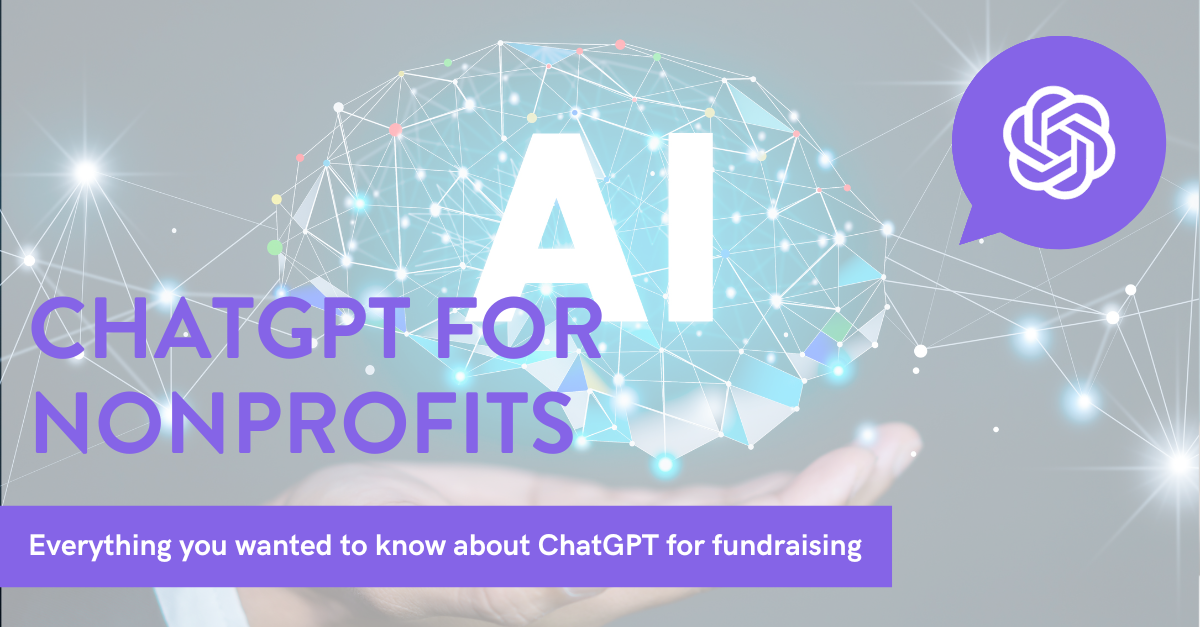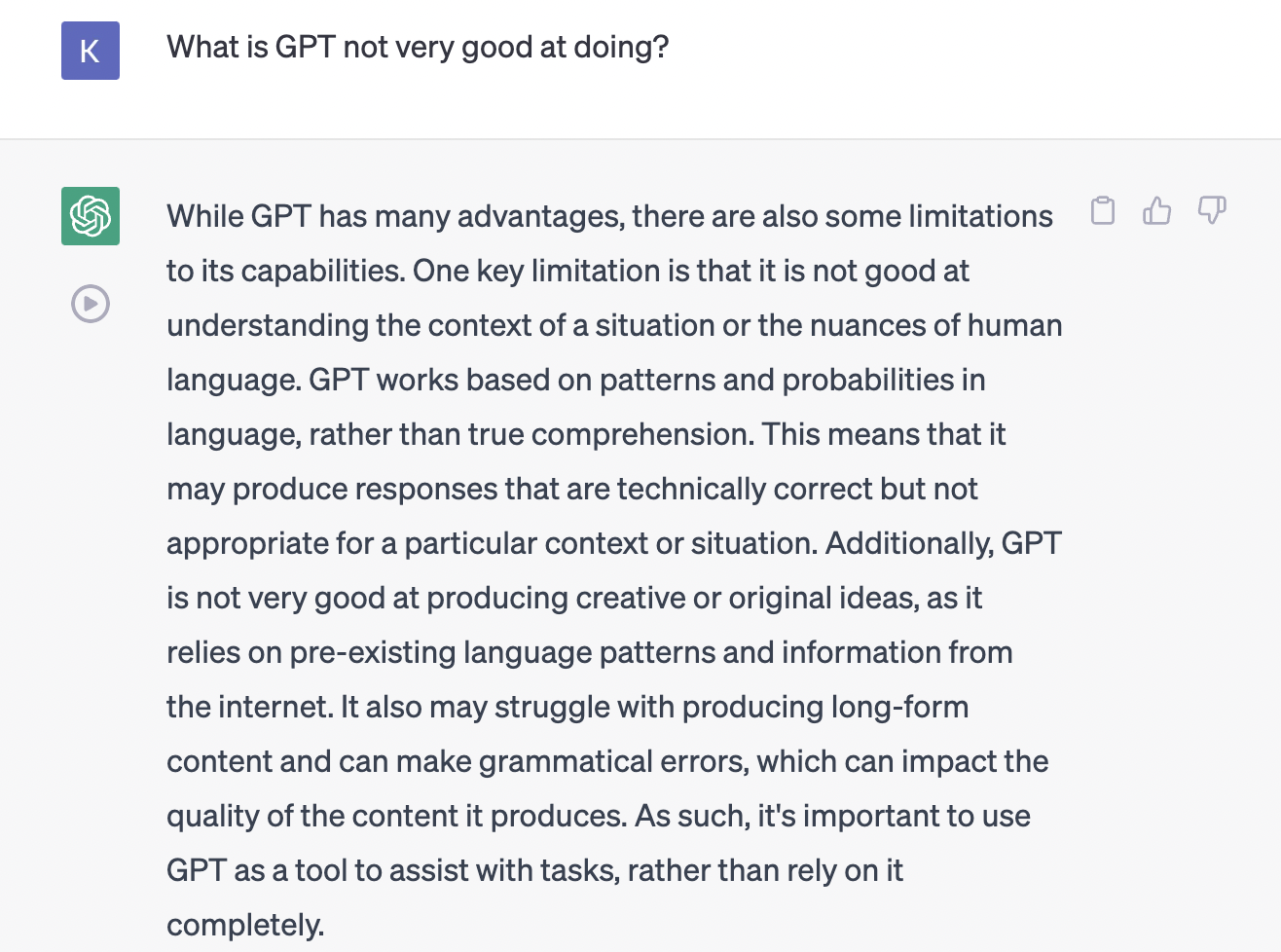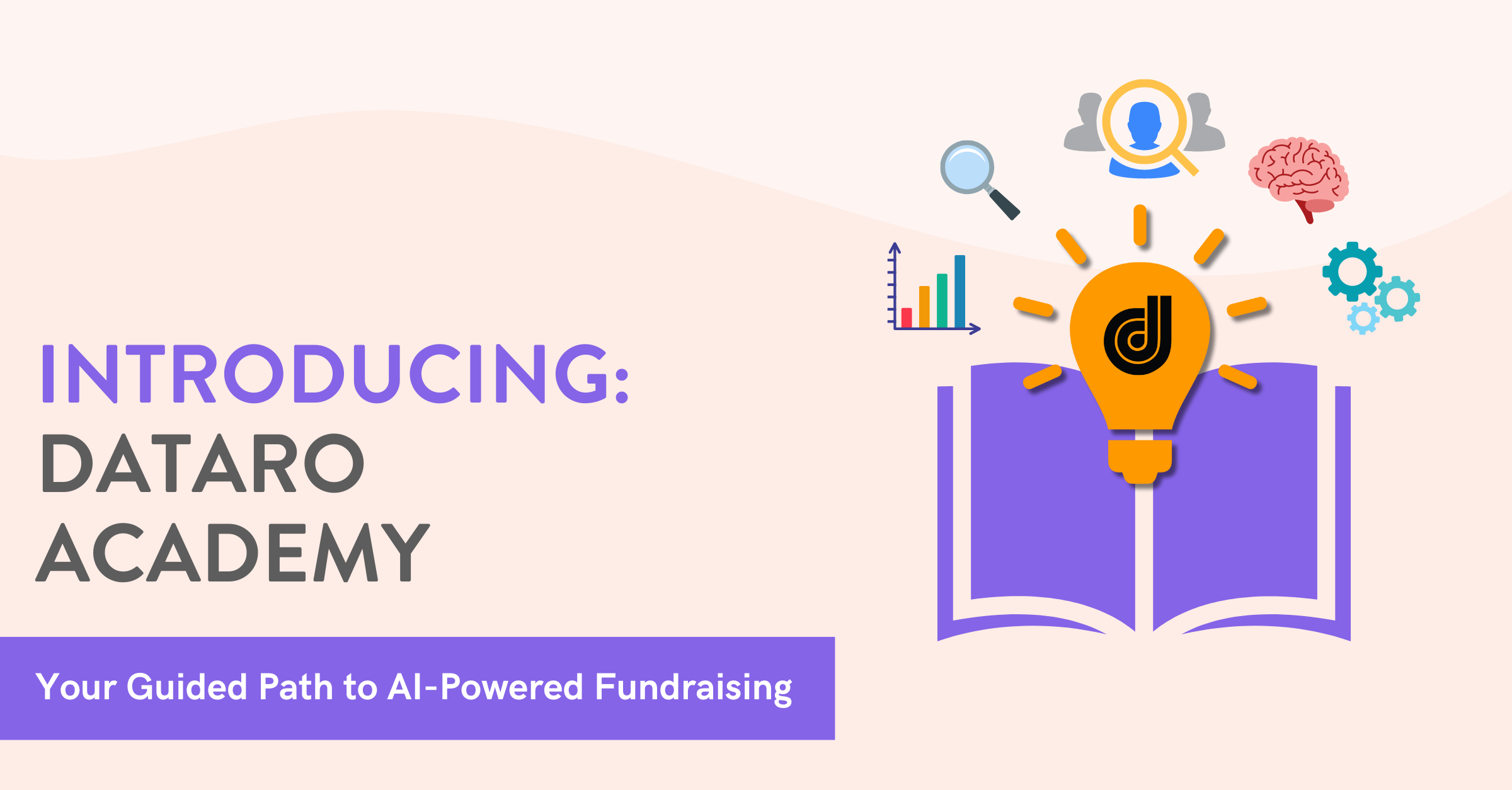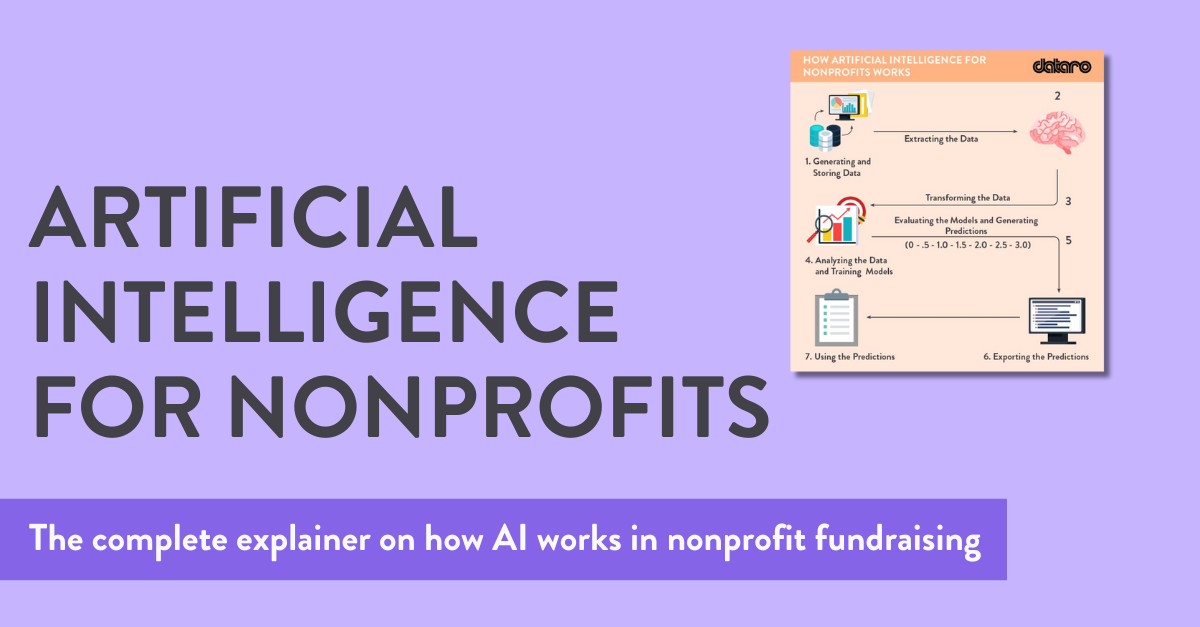
Here’s What You Need to Know About ChatGPT for Nonprofits
Katrina –
ChatGPT is the new AI technology on the block that has taken the world by storm since it was launched in November 2022 by creators OpenAI. Here at Dataro, we think this new AI chatbot is set to completely revolutionize the way nonprofits fundraise and can help time-poor fundraisers to do more, with less effort.
From automating mundane and time-consuming tasks to quickly generating fundraising copy and repurposing content across different channels, to data analysis and so much more – the potential applications of ChatGPT in fundraising are almost endless.
We know that fundraisers are time-poor professionals with never-ending to do lists. So this blog is here to tell you everything you need to know about ChatGPT – what it is, how to use it in your fundraising and why you want to start using it to do your job better. We’ll explore the potential benefits, the risks and how ChatGPT can help you achieve your fundraising goals.
Want to keep ahead of ChatGPT curve – you should join our GPT for Nonprofits Linkedin group here.
So what is ChatGPT exactly?
ChatGPT stands for Generative Pre-trained Transformer. Essentially it’s a group of large language models that use machine learning algorithms to understand human language and generate responses, delivered in the form of an AI chatbot.
It is a highly advanced and sophisticated artificial intelligence tool capable of generating human-like responses to a wide range of questions and statements. In fact, it’s designed to mimic human conversation where you ask a question or give a prompt, and ChatGPT will generate a response. But GPT’s capabilities extend far beyond simple conversation, as it is able to analyze vast amounts of data, recognize patterns, and even generate content such as blogs, social media posts and creative writing pieces like fundraising appeal letters, emails and so much more.

How does ChatGPT work?
GPT technology is part of a class of generative AI that leverages huge amounts of data to learn patterns and generate sophisticated outputs. Specifically, ChatGPT has been trained on a dataset of over 300 billion words from across the internet. The more data it has, the more it can learn. For example, with only a few million words it can learn how to put the right letters together to form basic words. With more training it can learn to form sentences, generate entire paragraphs and create whole documents with ease.
Working with hundreds of global nonprofits, we know fundraisers are constantly on the lookout for new and innovative ways to be more productive so they can spend their time doing the important things like engaging donors and raising more for their causes.
While ChatGPT (and AI in general) may seem daunting to some, it has been embraced by many forward-thinking organizations and fundraisers looking to stay ahead of the curve and increase their impact. ChatGPT can be used by fundraisers to quickly and efficiently produce high-quality content for their fundraising campaigns and donor engagement activities. And that’s just the tip of the iceberg!
How do you use ChatGPT?
With ChatGPT, all you have to do is create an account and ask a question known as a ‘prompt’ for the chatbot to respond to. Currently OpenAI have offered the basic version of this technology as a free tool with no limitation on the number of times you can use it. But users can also upgrade to a ChatGPT Plus account for faster processing and priority access to new features.
The key to using ChatGPT well is knowing how to provide the best prompts that define your goals and specific needs.
As with any AI language model, the quality of the output generated by ChatGPT is heavily influenced by the quality of the input it receives. In other words the age old saying, “garbage in, garbage out” applies when using ChatGPT too.
So getting the best results from ChatGPT relies on the user providing high-quality prompts or input. The prompts should be clear, concise, and specific, with a well-defined goal in mind. For example, if you want ChatGPT to generate content for a fundraising campaign, your prompt should clearly state the purpose, audience, and desired outcome of the campaign, among other things.
Equally prompts that are too vague or poorly defined will lead to output that is also vague, generic or even irrelevant to your goal. Creating prompts that are tailored to your specific needs and goals will ensure your output is high-quality and relevant to your fundraising efforts.
Are fundraisers already using ChatGPT?
Yes, savvy fundraisers have already jumped on the ChatGPT bandwagon to help them achieve more, with less effort.
In fact, 73% of the fundraisers in Dataro’s new “GPT for Nonprofits” LinkedIn user group had used GPT in their work. Almost half of these fundraisers were using the AI chatbot tool on a weekly basis, with 28% of fundraisers using it multiple times in a week. And it seems fundraisers are using the tool outside of their work too with 48% of fundraisers surveyed using it at least once a week.

This is exactly why we created the “GPT for Nonprofits” LinkedIn group – to help fundraisers already using the chatbot technology to get the most out of the new tool and do their jobs better. This group is open to fundraisers from across the globe and is a place for people to learn more about ChatGPT in fundraising and share their experiences and learnings with the community.
“At Dataro, we’ve been helping nonprofits leverage the power of AI in their fundraising since 2017 through our machine learning software. So when ChatGPT hit the scene we and fundraisers started playing with the tool and we knew we had a role to play in helping nonprofits leverage this technology to be more efficient and do more good,” said Tim Paris, Dataro CEO/Co-Founder.
So should you be using ChatGPT in your fundraising work?
The short answer is yes. There are some amazing applications that will save you time and the technology is only getting better and better.
What are the benefits of using ChatGPT in your fundraising?
The best thing about ChatGPT is that it is like having an extra assistant in your fundraising team. Using ChatGPT can be a game-changer when it comes to getting more done, in less time. And the best thing is it is simple to use and the tool is free (for now!).
Almost anyone can use the tool with the right prompts to generate high-quality content at incredible speed, automate time-consuming tasks or help with researching or summarizing documents or large amounts of information.
Used correctly GPT can help you streamline work, improve efficiency, save time and allow fundraisers to focus on what they do best – fundraising!
What is ChatGPT really good at?
So what is GPT good at doing? Here’s a few things fundraisers can leverage GPT for:
Doing repetitive tasks (the kind you could give a teenager)
ChatGPT is excellent at automating repetitive tasks. As a fundraiser, you likely have a long list of tasks that need to be done on a daily or weekly basis. These tasks could include drafting social media posts, sending thankyou communications to donors, or creating reports. By using GPT, you can streamline these processes and free up your time for more meaningful work. GPT can help you create templates for these tasks, which you can then tweak to fit your needs.
Translation exercises
GPT can be trained to translate text from one language to another. This can be especially useful for nonprofits that work in multilingual communities. For example, if your nonprofit operates in both English-speaking and Spanish-speaking communities, you can use GPT to translate your content from English to Spanish and vice versa. Additionally, GPT can be trained to translate text between different versions of a language (such as US English to UK English), or even between English and code.
Coming up with ideas and brainstorming
GPT can be used to generate ideas and assist your brainstorming to solve a specific problem or come up with creative concepts for fundraising campaigns etc. For example, if you’re struggling to come up with a theme for your next fundraising appeal, you can use GPT to generate a list of ideas. GPT can also help you refine your ideas by suggesting related topics and providing additional context.
What is ChatGPT not so good at doing?
While ChatGPT sounds like the holy grail for helping fundraisers achieve their goals, fundraisers should still exercise a level of caution when using the tool. While GPT can help you save time, there are some things that the new technology isn’t good at.
It’s not a mind reader
Unfortunately ChatGPT isn’t good at knowing what you want. Unless you tell it exactly what you need and even then you may need to ask the same question in different ways to get the desired response.
Additionally, the output generated isn’t always accurate. In fact, sometimes chatGPT can outright lie! So it is imperative that fundraisers check any output from chatGPT for factual accuracy.
It won’t come up with final, printer-ready content
You wouldn’t trust ChatGPT to produce a final version of a piece of content because it is not capable of understanding the nuances of human language and the context of your organisation or the problem you are trying to solve. This tool is best used to give you a head start for your creative content writing across your donor and brand communications.
Here’s what chatGPT had to say when we asked it what it wasn’t good at doing:

So, how are fundraisers currently using ChatGPT?
According to the fundraisers we surveyed, the most common reason for using ChatGPT in their fundraising was for tackling writer’s block and generating a first draft of content. Specifically the most common use was for drafting marketing copy across appeals and social media.
Fundraiser A: “I use ChatGPT to generate first drafts of communications, press releases, etc. I’ll use it to spin out a few variations of a story to get the groundwork laid before I add in specifics.”
Fundraiser B: “It’s been so great using Chat GPT to help with email fundraising campaigns, subject lines, ad copy and help brainstorming SEO-friendly headlines for web articles.”
The next most common use of ChatGPT was to improve writing in general, especially when it came to impact report writing. Other fundraisers commonly used the AI tool to help with campaign or content ideation, for grant writing or for summarizing long documents. Some fundraisers were already using ChatGPT to help with their fundraising data analysis.
What are some of the best practices for prompting GPT?
Having played around with ChatGPT our team of data scientists and fundraisers have come up with a few best-practice tips for prompting ChatGPT to improve the quality of the outputs it can generate for fundraisers:
Use clear and specific prompts
Be very clear in the prompts you give GPT. For example, when asking ChatGPT to write you a fundraising piece of content you should provide as much detail or prompts as possible including the purpose, who the audience is, the tone of voice, brand language guidelines, the expected outcomes etc. This will help GPT to remain on topic and produce a response that is aligned to your audience.
Context, context, context
Give ChatGPT loads of context to the situation or task you are wanting help with. The more detail the better and more likely you will get a useful response that you can iterate on further.
Ask how it came up with the response
There are some famous cases of ChatGPT failing a simple math equation but getting the calculation right when you ask the chatbot to step through its process for calculating the result. If you get a response from ChatGPT that misses the mark, ask the chatbot to step you through its thinking when it generates a response that misses the mark.
What should you NOT do with ChatGPT?
ChatGPT isn’t the holy grail to your fundraising woes. There’s some things you should never let ChatGPT do:
Don’t place too much trust in ChatGPT (it can’t replace the human touch)
If you’ve read this far by now you would know that you should never use any output from ChatGPT as a first and final piece of content. Unfortunately ChatGPT makes mistakes, lacks context and is unable to understand the nuances of human language. So you should NEVER trust it to automatically send anything it creates (like an email or grant document) without a human editing first!
Never provide personal information
Never, ever, ever upload personal information to ChatGPT about you or your donors. And never ask the chatbot to share personal information about your or your donors. There are some lines that should never be crossed.
Don’t give up!
But don’t give up on your first try with ChatGPT. This can be a revolutionary tool when used correctly but you need to invest the time and effort in learning how to use the chatbot to its best advantage. Take the time to learn the skill of how to work with ChatGP and you are setting yourself up for future success.
What are the risks and ethical considerations?
ChatGPT is a useful tool for fundraisers to get more done in less time, but it isn’t the perfect solution and there are risks and ethical considerations you need to be aware of before using this technology in your fundraising.
Perpetuating bias, false information and fake news
One of the biggest risks to consider is the potential for inaccurate or misleading information in the AI-generated responses. Unfortunately ChatGPT sometimes “lies” when it doesn’t know the answer to a question or generates false information either by intent or mistake.
Another risk is the potential for bias in the response or language generated by ChatGPT which can perpetuate harmful stereotypes or inaccurately represent certain groups of people. Because the chatbot learns from patterns in the data it is trained on, if the data contains biases, the output will likely also reflect those biases.
And finally there is the risk of hallucinations and fake news generated by ChatGPT because the chatbot can generate fictional content. It’s important for fundraisers to be aware of these risks and take steps to mitigate them, such as fact-checking information generated by ChatGPT and ensuring that language is inclusive and free from biases and is aligned with the organization’s values and mission.
There is also the potential for plagiarism and attribution issues, as ChatGPT can generate text in the style of other writers without credit or royalties.
What’s the first step to getting started?
It’s quick and easy to start using ChatGPT in your fundraising or daily life. Go to the Open Ai website and click on the Try ChatGPT button to set up your account. It’s free and you’ll be up and running in no time.
What’s ahead: Dataro’s new AI Assist
We believe in the GPT technology so much that we’re building a new application specifically designed for fundraisers. Our new AI Assist will be the ultimate fundraising assistant, capable of writing on-brand and fundraising-specific copy for your fundraising activities and donor communications. As experts in AI and machine learning our new AI Assist means you won’t need to learn how to use ChatGPT and develop effective prompts. Because we’ve done the hard work for you!
We’re currently in Beta and will be launching soon.




